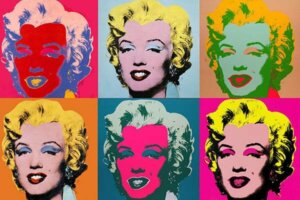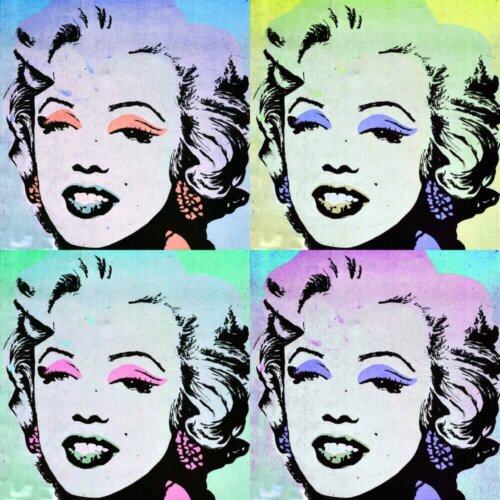Marilyn Monroe and Pop Art Style

Marilyn Monroe was the most desired woman of the 20th century. She was also a muse of the American artist Andy Warhol and pop art. This artist painted Marilyn Monroe after she had already died.
Marilyn Monroe rose to stardom posthumously. She had greater popularity in death than she ever did during her life.
Andy Warhol, whose real name was Andrew Warhola, contributed to cementing Monroe’s supernatural existence through his paintings.
This highly creative North American artist discovered pop art around 1960. During the 1950s, Warhol worked as a commercial illustrator for brands like Tiffany & Co. and Vogue. However, now pop art and Warhol are one and the same and difficult to separate.
Many people know Warhol for being a great enthusiast of Hollywood stars and great American writers. He frequently spent time in these circles. Also, he believed in the idea of “15 minutes of fame.” This phrase reflected the transcience of fame during his time.
Pop art

The pop art movement was a reaction against abstract expressionism. It came about through a change of principles. As a result, the surreal roots of abstract expressionism were replaced by the dadaists of pop art.
The movement aimed to explore the borders of art. Marcel Duchamp was one of the first artists to feature everyday objects in galleries and museums.
Another artist who many people consider to be a precursor to pop art is Yves Klein. Klein used monotony and a lack of differentiation in his work. Thanks to this, he is linked to the ideas and art of Warhol.
Also, experimentation with collages was important for the emergence of pop art. Many cubist artists invented different types of collages to explore the limits between reality and representation.
As a result of previous experiments, surrealists and dadaists were able to expand their potential. Artists played with the “art of assemblage,” which allowed them to create relationships with works of art from pre-existing and different objects.
In 1961, MoMA dedicated an exhibition to “The Art of Assemblage.” This was a starting point for consolidating the pop art movement. Pop art was born in the United Kingdom. And it expanded thanks to the new North American urban culture. Through this movement, artists questioned and responded to the romantic solemnity of the British art of the 1940s.
American pop art

Promoters of pop art claimed that art should be intelligent, above all. However, it should also encourage a popular base and reflect icons of pop culture.
However, many people believe that the themes covered by pop art were banal. On the other hand, the aesthetics of this trend were sophisticated. Pop art also became an art of critical reflection, as artists rejected prejudices. This was well-received by audiences.
North American pop art artists were much more pragmatic. They sought inspiration in advertising. Their goal was to shape art that was as diverse as contemporary life after World War II.
These artists sought to make art accessible to all social classes. They also wanted to foster a connection between art and everyday life and between art and kitsch.
Imperfection is beauty, madness is genius, and it’s better to be absolutley ridiculous than absolutely boring.
-Marilyn Monroe-
Marilyn Monroe and pop art

Andy Warhol began a series of paintings of this movie star in August 1962. This was shortly after Marilyn’s suicide. This series of paintings became very well-known and became a cult image during the 20th century.
Andy Warhol found Marilyn Monroe to be a symbol of myth and stereotype.
In these series of paintings, you can see that under her image, there is a simplicity of strokes that is typical of advertising. This is akin to the publicity that forced Marilyn to always appear seductive and mischievous.
In the paintings of Marilyn Monroe, Warhol highlighted her hair, eyes, and mouth with splashes of color that don’t match her true coloring. Warhol did this to mark and highlight the artificiality of the image.
Theories about Marilyn Monroe and Warhol
Over time, there have been many theories about the hidden symbolism of these portraits. Warhol’s message to society with the paintings is another mystery that doesn’t have a clear answer.
However, Andy Warhol himself, on various occasions, claimed to be a transparent person. “If you want to know everything about Andy Warhol, just look at the surface of my paintings and films and me, and there I am. There’s nothing behind it,” said Warhol.
On the other hand, Warhol tried to hide any sign of artistic intention in his paintings. However, it’s undeniable that he put a lot of thought into his paintings, including the Marilyn series.
Regardless of the message, the image of the beautiful Marilyn Monroe is a great example of the pop art movement. They ensure that this movement will continue to be appreciated for a long time or, perhaps, forever.
Marilyn Monroe was the most desired woman of the 20th century. She was also a muse of the American artist Andy Warhol and pop art. This artist painted Marilyn Monroe after she had already died.
Marilyn Monroe rose to stardom posthumously. She had greater popularity in death than she ever did during her life.
Andy Warhol, whose real name was Andrew Warhola, contributed to cementing Monroe’s supernatural existence through his paintings.
This highly creative North American artist discovered pop art around 1960. During the 1950s, Warhol worked as a commercial illustrator for brands like Tiffany & Co. and Vogue. However, now pop art and Warhol are one and the same and difficult to separate.
Many people know Warhol for being a great enthusiast of Hollywood stars and great American writers. He frequently spent time in these circles. Also, he believed in the idea of “15 minutes of fame.” This phrase reflected the transcience of fame during his time.
Pop art

The pop art movement was a reaction against abstract expressionism. It came about through a change of principles. As a result, the surreal roots of abstract expressionism were replaced by the dadaists of pop art.
The movement aimed to explore the borders of art. Marcel Duchamp was one of the first artists to feature everyday objects in galleries and museums.
Another artist who many people consider to be a precursor to pop art is Yves Klein. Klein used monotony and a lack of differentiation in his work. Thanks to this, he is linked to the ideas and art of Warhol.
Also, experimentation with collages was important for the emergence of pop art. Many cubist artists invented different types of collages to explore the limits between reality and representation.
As a result of previous experiments, surrealists and dadaists were able to expand their potential. Artists played with the “art of assemblage,” which allowed them to create relationships with works of art from pre-existing and different objects.
In 1961, MoMA dedicated an exhibition to “The Art of Assemblage.” This was a starting point for consolidating the pop art movement. Pop art was born in the United Kingdom. And it expanded thanks to the new North American urban culture. Through this movement, artists questioned and responded to the romantic solemnity of the British art of the 1940s.
American pop art

Promoters of pop art claimed that art should be intelligent, above all. However, it should also encourage a popular base and reflect icons of pop culture.
However, many people believe that the themes covered by pop art were banal. On the other hand, the aesthetics of this trend were sophisticated. Pop art also became an art of critical reflection, as artists rejected prejudices. This was well-received by audiences.
North American pop art artists were much more pragmatic. They sought inspiration in advertising. Their goal was to shape art that was as diverse as contemporary life after World War II.
These artists sought to make art accessible to all social classes. They also wanted to foster a connection between art and everyday life and between art and kitsch.
Imperfection is beauty, madness is genius, and it’s better to be absolutley ridiculous than absolutely boring.
-Marilyn Monroe-
Marilyn Monroe and pop art

Andy Warhol began a series of paintings of this movie star in August 1962. This was shortly after Marilyn’s suicide. This series of paintings became very well-known and became a cult image during the 20th century.
Andy Warhol found Marilyn Monroe to be a symbol of myth and stereotype.
In these series of paintings, you can see that under her image, there is a simplicity of strokes that is typical of advertising. This is akin to the publicity that forced Marilyn to always appear seductive and mischievous.
In the paintings of Marilyn Monroe, Warhol highlighted her hair, eyes, and mouth with splashes of color that don’t match her true coloring. Warhol did this to mark and highlight the artificiality of the image.
Theories about Marilyn Monroe and Warhol
Over time, there have been many theories about the hidden symbolism of these portraits. Warhol’s message to society with the paintings is another mystery that doesn’t have a clear answer.
However, Andy Warhol himself, on various occasions, claimed to be a transparent person. “If you want to know everything about Andy Warhol, just look at the surface of my paintings and films and me, and there I am. There’s nothing behind it,” said Warhol.
On the other hand, Warhol tried to hide any sign of artistic intention in his paintings. However, it’s undeniable that he put a lot of thought into his paintings, including the Marilyn series.
Regardless of the message, the image of the beautiful Marilyn Monroe is a great example of the pop art movement. They ensure that this movement will continue to be appreciated for a long time or, perhaps, forever.







